I’ve mentioned in the past that I’m a big fan of old-school Sesame Street books. And, by “old school”, I’m typically talking about the pre-Elmo era. Maybe it’s just nostalgia, but Sesame Street always felt so much more engaging to me when the street was a little grimy and urban (it looks so gentrified now), when Jim Henson and Frank Oz were stationed beneath Ernie and Bert, and when you could always find an afro or two sitting at the counter at Mr. Hooper’s store. One of my favorite Sesame Street books from this era is The Sesame Street Word Book, illustrated by Tom Leigh, a tremendous illustrator with a wide body of Sesame Street projects on his resume.
However, there are TWO versions of The Sesame Street Word Book out there – the original 1983 edition and a re-issued 1998 edition – and one is CLEARLY superior to the other. Let me give you a quick overview of the book itself and then I’ll let you know which one to embrace and which to avoid.
If you’ve never seen it before, The Sesame Street Word Book is probably the closest thing I’ve ever found to a Sesame Street version of a Richard Scarry book. My daughter adores all of those over-sized Scarry books like the Best Word Book Ever, What Do People Do All Day?, and Cars and Trucks and Things That Go – those big, uber-detailed landscape spreads packed with scenes of city life, a huge cast of characters, and absolutely everything labeled. They make great road trip books and they’re the kinds of books that a kid can get lost in for an entire afternoon.
As I mentioned, The Sesame Street Word Book follows the Richard Scarry model pretty closely, offering a variety of scenes featuring Sesame Street characters where we learn about a big swath of topics, everything from feelings and shapes to what we can expect to find in a doctor’s office or in a supermarket.
The book opens with a great “Note to Parents” from the Children’s Television Workshop, which tells us: “The Sesame Street Word Book provides children with a rich and colorful environment in which to explore the world of words. Entertaining scenes introduce more than 1000 words in context to help children’s expand and organize their vocabulary. Detailed pictures with easy-to-read labels demonstrate that words are symbols – for actions, people, places, and things.”
That’s probably one of the best definitions of a “word book” that I’ve ever heard. We had a lot of word books in rotation in my daughter’s room when she was very young, but, as she got older, she became less and less interested in them. Many word books come across as just illustrated dictionaries and, once my daughter learned all of the terminology for kitchen utensils or farm animals, she very quickly lost interest with most of the word books in our library. It’s a testament to the quality and depth of books like The Sesame Street Word Book and the works of Richard Scarry that I still occasionally find my daughter flipping through them on rainy days.
While Tom Leigh doesn’t have Richard Scarry‘s virtuoso talent (who does?), he is an incredibly skilled artist and the level of detail and character he packs into The Sesame Street Word Book is amazing. With the possible exception of Michael Smollin (illustrator of The Monster at the End of this Book), I consider Leigh to be the definitive Sesame Street illustrator of all time (which is saying something when you realize how many Sesame Street books have been published over the years).
But, as I mentioned at the start, Leigh produced TWO different versions of The Sesame Street Word Book – the original 1983 version and a re-issued version in 1998. And, as you may be able to guess from the introduction to this article, I greatly prefer the original version. But that’s not just my old-school Sesame nostalgia talking. The fact is – the 1983 Sesame Street Word Book is a much longer, deeper, and all-around better piece of work. While you can sometimes find descriptions online of the 1998 version adding “additional art,” the truth is that the 1998 revision cuts out almost a third of the original book for no real discernable reason.
So, what’s so different about the two versions of The Sesame Street Word Book? You can notice the first variations on the cover – the illustrations are almost identical, except the 1998 edition adds Elmo, Zoe, and Baby Natasha sitting on the stoop at 123 Sesame Street. It would be unfair to say that the 1998 version is worse just because it’s a product of the Elmo-era – there have been some great moments in post-Elmo Sesame Street – but the more modern revision oddly just seems to hack and slash away at anything that references the show’s history.
(My favorite variation in the cover illustrations is that, on its back cover, the 1998 edition alters an illustration of Grover roller-skating to add a helmet and inline skates.)
If you can distinguish between the two versions by the presence of Elmo on the cover, you can really distinguish the difference in the overall quality and depth between the versions by looking at the table of contents. The 1983 edition has 68 scenes listed in the table of contents – the 1998 edition only has 44. I’m not sure why the Children’s Television Workshop wanted the re-issued version to be 36% shorter than the original. It just seems like such a weird choice.
I can totally understand why certain alterations were made. The endpapers of the 1983 Sesame Street Word Book feature illustrations of characters like Mr. Hooper and David who were no longer on the show in 1998. I can see why their pictures would’ve been edited out in a re-issue, but there doesn’t seem to be much of a rhyme or reason to why the 1998 edition chose to cut some images and simply replace others.
For example, there’s a spread in the 1983 edition called “Prairie Dawn’s Room,” which was altered in the 1998 edition to become “Zoe’s Room.” It is literally the exact same illustration for both pages – the only thing Leigh changed was that he swapped out a picture of Prairie Dawn for a picture of Zoe. Nice and simple and, while I greatly prefer Prairie Dawn, that edit makes sense to me.
Other edits are completely baffling to me. There is FAR less labeled in the 1998 edition, which seems like a bizarre choice. Why a new edition of something called “The Sesame Street Word Book” would want to feature significantly less WORDS than its original edition is completely beyond me. The 1998 edition also cuts several spreads featuring the old-school character Farley – a young green-skinned, orange-haired boy – who was never that popular even in the early years of Sesame Street. The Farley sections feature some really engaging “word book” material, all about family trees and reading a clock, none of which feels dated or old. Unless they were trying to save on paper costs, I have no idea why they would jettison this material.
In my mind, the absolute worst decision that the 1998 Sesame Street Word Book made was to delete almost every single mention or image of the show’s human cast members. (There is one spread in the 1998 version – “Big Bird at the Airport” – where you can briefly see Maria, but that’s it.) One of the best things about Sesame Street the show is that it presents this vibrant community where all different races, ages, and species (both puppet and human) live together and learn about the world together. And the human cast of Sesame Street plays a big role in that community. So, particularly because so many of the original Sesame Street human cast members are still on the show today – Maria, Luis, Bob, Gordon, and Susan are still hanging in there – I just don’t understand this decision. And, even if they did decide to edit out the human actors, I don’t know why Leigh couldn’t just swap out their images (like he does in other sections) and leave the original pages whole.
I will say – the 1998 edition of The Sesame Street Word Book DOES add in one new 2-page spread that wasn’t in the original 1983 version. However, it’s a very simple, not-particularly detailed look at the lobby of the Furry Arms Hotel. If you can’t remember the Furry Arms Hotel, I don’t blame you. It comes from a short-lived (and often-reviled) period in Sesame Street‘s history, a period you can read about in Michael Davis’ excellent nonfiction work Street Gang: The Complete History of Sesame Street.
(Short version – In the early 1990s, Sesame Street sunk a lot of money into expanding their set and cast of characters, an expansion that was known as “Around the Corner.” To quote Michael Davis: “Viewers soundly rejected the turning away from the core characters that made the series so successful for so long.” The only major character that remains on the show from the “Around the Corner” era is Elmo’s friend Zoe.)
This is all a very, very long and weirdly obsessive way for me to tell you that The Sesame Street Word Book is a fun, dynamic word book in the best tradition of Richard Scarry, but you have to be careful about what edition to you pick up. Both editions are currently out-of-print, but it’s fairly easy to find used copies online.
ONE WORD OF WARNING – You will want to look for copies on eBay or you will want to look for slightly used copies on Amazon Marketplace. At the moment, Amazon only has a listing for the 1998 truncated, not-great edition of the book and, for a new copy, they’re asking $139.83. That is CRAZY. I found very clean, very decent versions of BOTH editions of the book on eBay for ten dollars or less. If you’re OK with used books and if your young child loves Sesame Street, I think they’d enjoy The Sesame Street Word Book… but, if they have good taste, they’ll enjoy the 1983 version even more.
THE DETAILS ON THE SESAME STREET WORD BOOK:
AGE RANGE: You could drop this book in front of a baby and they’d be fine. My one caveat is that word books have a much shorter shelf-life than normal storybooks in my experience, so older kids may not be interested.
PAGE COUNT: 1983 edition = 70 pages; 1998 version = 45 pages.
RELATED WEB SITES: Here’s a link to the official Random House page for Sesame Street books, but, as I mentioned, The Word Book is out of print, so you won’t find much information on it. If you’re interested in learning more about illustrator Tom Leigh – here’s his profile page on the great Muppet Wiki.
BUY IT, BORROW IT, OR FORGET IT?: I don’t think this is an essential read. There are a lot of superior word books out there, particularly the works of Richard Scarry. But, if you can find a cheap copy and if your kid is a huge Sesame Street fan, it’s worth picking up. (And it’s totally worth borrowing if your library has it.)
IF YOU LIKED THE SESAME STREET WORD BOOK, YOU MIGHT ALSO LIKE:
- Cars and Trucks and Things That Go by Richard Scarry – I wrote this about Cars and Trucks and Things That Go last year: “I’m just going to put this out there – Richard Scarry books are, hands-down, the BEST road trip kids’ books of all time. They really are. And many of the reasons why this is true that go well beyond Scarry’s obvious skill as a storyteller and illustrator. First, normally, Richard Scarry’s books are HUGE, which is PERFECT for a car trip. His books, like Cars and Trucks and Things That Go, are large, wide but thin hardcovers that give kids 60+ pages of reading material. … Next, Scarry packs a ridiculous amount of detail into his two-page spreads. One spread might have forty vehicles, a whole town map, multiple animal families doing multiple things, 30+ jokes, and tons of visual easter eggs and hidden pictures for your kids to obsess over and while away the hours with. (My daughter really loves trying to find Goldbug and Lowly Worm on each page.) Scarry gives his young readers an experience akin to looking at an illuminated manuscript or a medieval tapestry or a Diego Rivera mural – they could flip through Scarry’s illustrated tableaus for days and still discover new details that hadn’t jumped out at them before.”
- Where’s Waldo? by Martin Handford – The Where’s Waldo books don’t try to place vocabulary words into context like most word books do, but, like the works of Richard Scarry and The Sesame Street Word Book, the Waldo books do create large-sized, immersive vistas that are designed in a way that encourages children to explore them endlessly. And, when you see a kid with a Waldo book on his or her lap, pouring over the pages, checking every nook and cranny for Handford’s perpetually camouflaged traveler, it’s a really fun sight to behold. (The same thing goes for Jean Marzollo’s I Spy books. They’re tremendously interactive, engaging visual experiences for kids.)
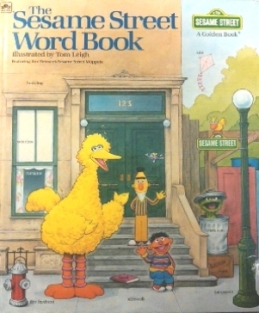
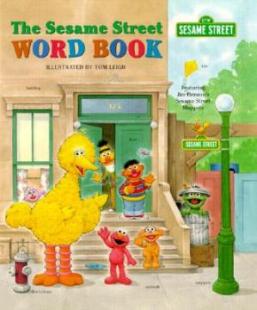
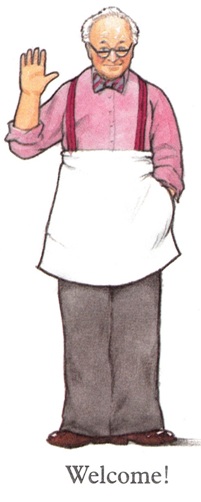
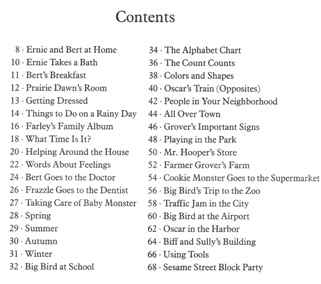
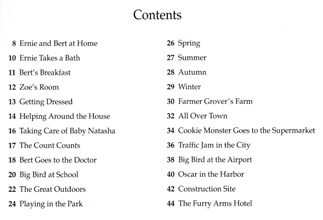
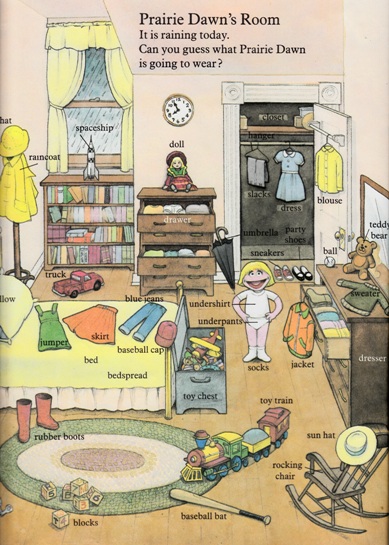
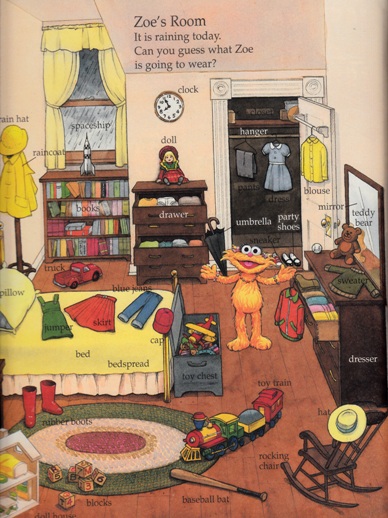
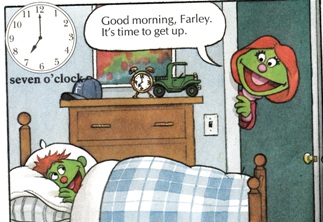
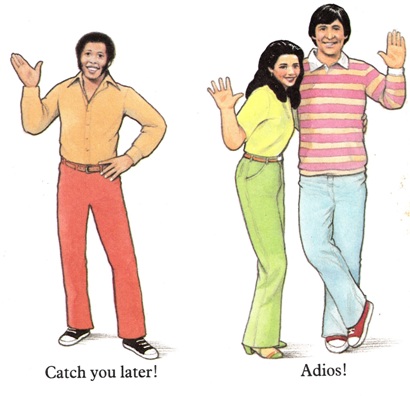
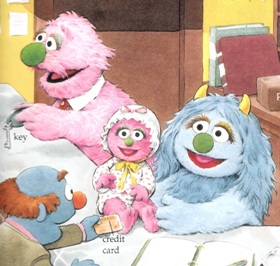
{ 2 comments… read them below or add one }
THANK YOU!! I remember loving the old version when I was a child. I couldn’t remember the name, but I remembered the pictures (particularly when Cookie Monster goes to the grocery store, I stared at that spread for eons). A couple of searches brought me here, and now I have enough info to buy it to share with my kiddo. Thanks!!
I think we might have one of these in our library. My 6yo loves Richard Scarry so I’ll keep my eye out for this if we don’t already have it.
Also, I love that you are reviewing these older editions. It’s nice to find some old gems. And I hear you about Elmo.
You must log in to post a comment.